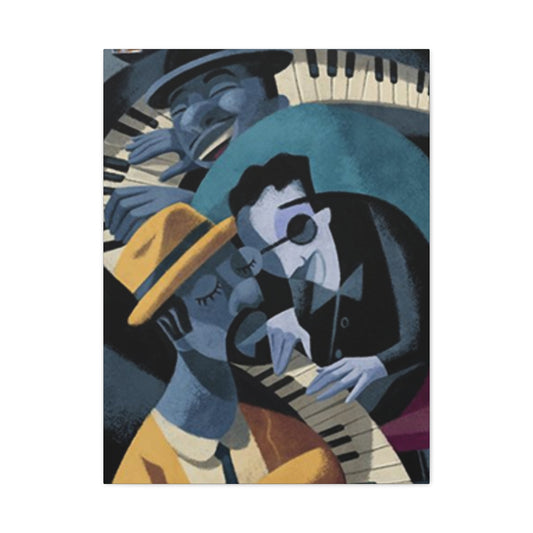If you're settling into a new residence or aiming to breathe life into a space you've long called home, few design choices offer as much transformative power as wall art. Often overlooked, yet deeply impactful, artwork doesn't just dress the walls—it speaks volumes. It can alter the energy of the room, spark joy, and most importantly, serve as a visual embodiment of your story, values, and aesthetic.
Your living room is the central artery of your home, the setting for heartwarming conversations, lazy Sunday mornings, and festive evenings. Because it’s a place where people gather, unwind, and express themselves, the art you choose for its walls becomes more than decor—it becomes an invitation into your world.
Start with Emotion: What Should the Room Make You Feel?
The process of choosing wall art for your living room begins not with measurements or color palettes but with emotion. More than any other decorative element, artwork has the rare power to evoke a specific mood, trigger a memory, and stir a feeling that lingers long after a guest has departed or a day has ended. Your living room is not just a space—it’s a canvas for self-expression, and emotion is the paint that gives it depth.
Before selecting artwork, pause and ask yourself: what sensation should this room bring into your life each time you enter it? Should it serve as a sanctuary of serenity after the clamor of the outside world? Or should it burst with vibrancy, inspiring conversations, laughter, and creativity? These are not trivial considerations—they are the foundation of meaningful home design.
Artworks that speak to emotion elevate a space from merely attractive to soul-stirring. A photograph of a quiet mist rising over a lake can instantly lower your heart rate. A painting that explodes in hues of crimson and ochre can uplift your spirit and energize your day. Art invites us to feel more deeply, think more freely, and live more authentically. And when those emotions are embedded in the walls of your most-used space, the result is a living room that doesn’t just look good—it feels alive.
Building an Emotional Framework for Your Wall Art
To select artwork with intention, it helps to define an emotional framework for your space. This isn’t about assigning a singular emotion to a room, but rather understanding the dominant feelings you want to foster there. For example, if your living room is where you unwind after long workdays, consider pieces that exude calmness and stillness. Muted color schemes, natural scenes, and gentle brushwork can imbue the room with a sense of repose and reflection.
On the other hand, if your living room is the heartbeat of your home—a place where guests gather, children play, and stories are shared—opt for expressive pieces that ignite warmth and enthusiasm. Artwork with dynamic compositions, playful textures, or even whimsical themes can amplify joy and conviviality.
You might also wish to create an atmosphere of nostalgia or reflection. Vintage prints, sepia-toned photographs, or personal mementos transformed into wall art offer a timeless charm that keeps your personal history ever-present. This emotional layering turns a wall into a silent storyteller, whispering moments of your life back to you each day.
It’s important to trust your instincts when selecting emotionally resonant art. The connection between art and viewer is often immediate and visceral. If a certain piece makes you pause, evokes a long-lost memory, or simply draws a smile without explanation—that's the one to bring home. Your living room deserves more than generic wall decor. It deserves stories, symbols, and soul.
Infusing Your Living Room with Personality and Atmosphere
When curating wall art to reflect a desired emotional ambiance, allow your personality to take the lead. Instead of chasing trends, seek imagery that aligns with your inner landscape. A moody coastal seascape may echo your longing for solitude and introspection. A sun-bleached alleyway in Tuscany might celebrate your love of travel and exploration. A minimalist abstract piece might reflect your need for clarity and structure in a complex world.
For those drawn to minimalism and tranquility, monochromatic or nature-inspired pieces can create a peaceful oasis. Black and white photographs, soft landscapes, or botanical illustrations are subtle yet profoundly calming. These works often invite introspection and create a harmonious backdrop for quiet moments, reading, or meditative reflection.
|
Related Catagories: |
Alternatively, maximalist tastes can be reflected through layered textures, bold hues, and expressive art that commands attention. Think colorful contemporary paintings, mixed-media collages, or oversized prints that saturate the space with drama and emotion. These selections not only energize the room but also express confidence and individuality.
There’s also a place for art that evolves with your emotional state. Rotating seasonal art—lush florals in spring, golden leaves in autumn, snowy scenes in winter—can keep your living room emotionally relevant and visually dynamic throughout the year. This approach allows your walls to reflect the fluid nature of life and keep your connection to your space fresh and responsive.
The Subtle Power of Emotional Design in Everyday Living
We often underestimate how deeply our surroundings influence our emotional health. A living room adorned with personally meaningful wall art can be a quiet source of encouragement, healing, and joy. Emotional design isn’t about melodrama—it’s about resonance. It’s about allowing your space to support you in your everyday life, offering what you need, when you need it.
Imagine walking into your living room after a stressful commute and being met by a serene photograph of an empty shoreline. The soft tones and distant horizon invite your breath to deepen and your shoulders to drop. Or picture returning from a vacation, wistfully nostalgic, only to find comfort in a framed moment from that very trip hanging above your bookshelf. These subtle shifts matter. They contribute to your sense of well-being and groundedness.
Wall art has the rare capacity to anchor you in the present while also connecting you to the past or projecting dreams for the future. A room adorned with emotionally conscious artwork becomes more than a shelter—it becomes a vessel for the human experience.
In practical terms, emotional wall art can also help guide the rest of your design. Once the artwork sets the tone, other elements—furnishings, textiles, lighting—can follow its emotional cues. A tranquil painting might call for linen drapes and natural wood tones. A bold graphic piece might inspire geometric rugs or statement lighting. In this way, art doesn't just reflect the room’s energy—it creates it.
Ultimately, when you start with emotion, you design with authenticity. Your wall art becomes more than a decorative accent; it becomes a visual diary, a memory keeper, a daily motivator. Whether calming, exciting, nostalgic, or contemplative, the emotion your art evokes will linger far beyond the moment you hang it. It will echo in every conversation, every quiet evening, every morning light that touches its frame.
Let your emotions lead your choices. In doing so, you don’t just decorate your walls—you enrich your life.
Art That Welcomes and Introduces: What Should Guests Know About You?
Your living room is more than just a place to sit—it’s a space that speaks, often before you ever say a word. As the most visible and commonly visited area in your home, your living room becomes a reflection of identity. And nothing captures personality and life stories quite like the art that graces its walls.
Wall art acts as a silent host. It greets guests, sets expectations, and invites exploration. Whether your taste leans toward bold abstract canvases, serene nature photography, or expressive family portraits, each piece you hang contributes to the narrative of who you are. More than visual flair, this art forms the emotional language of your home—a language that welcomes, intrigues, and introduces.
The right wall art offers more than a decorative flourish. It brings substance to style, turning your living room into a meaningful dialogue between you and the people who enter. It creates moments of curiosity, nostalgia, and admiration while revealing the layers that make up your journey, passions, and sense of home.
Creating a Visual Introduction Through Personal Expression
The art in your living room acts like an open book. Each canvas, photograph, or framed quote contributes a sentence or chapter to your life’s story. Whether it’s a panoramic shot of a place that left a mark on your heart or a cherished childhood painting rediscovered in a drawer, these pieces are deeply personal.
One of the most compelling approaches is to curate a gallery wall that narrates your interests and values. For globe-trotters, a collection of travel photography can turn walls into a passport of memories. A shot of a rain-drenched alley in Lisbon, a sweeping desert in Morocco, or the twinkling skyline of Tokyo tells visitors that you’re curious, adventurous, and connected to the world.
Artists and creatives might gravitate toward modern or abstract art, pieces that challenge convention or blur reality. Geometric shapes, layered textures, and expressive strokes offer insight into a love of imagination, spontaneity, and thought-provoking design. These works don’t scream for attention; they draw you in and make you think.
For those whose hearts revolve around home and family, wall art might take the form of captured moments—candid photos, playful watercolors painted by a child, or embroidered quotes passed down through generations. These items do more than fill space; they root the room in affection, offering comfort and authenticity to anyone who enters.
Your art becomes a curated autobiography, a personal tapestry stitched with experiences, emotions, and aesthetics. Even without words, it creates an atmosphere of openness and allows guests to connect with you on a deeper, often emotional, level.
Letting Lifestyle Influence Wall Art Selection
Art is not a one-size-fits-all expression. It should reflect your rhythm of life, your worldview, and the energy you want to share with those around you. That’s why your lifestyle is such a vital guide when selecting living room wall art.
If you live a fast-paced, urban existence, your wall might benefit from structured, contemporary pieces—grayscale architectural sketches, cityscape photography, or bold modernist graphics. These works channel movement, ambition, and sleek sophistication. They mirror your metropolitan mindset and create a space where modernity thrives.
In contrast, nature lovers might opt for botanical illustrations, forest landscapes, or ocean photography. Such imagery brings serenity indoors and subtly tells visitors that you draw strength from natural beauty, solitude, and balance. It reflects a grounded lifestyle rooted in mindfulness and appreciation for the earth’s rhythms.
Minimalists may choose to showcase art that is refined and subtle—simple line drawings, monochromatic palettes, or single-subject prints with lots of negative space. These selections convey clarity, calm, and deliberate living, signaling a taste for elegance over excess.
Whatever your rhythm, the key is alignment. Art should match the essence of your daily life so that your living room becomes not just a visual experience but an energetic extension of how you live, think, and feel.
Turning the Living Room into a Conversational Canvas
The most compelling art doesn’t just sit quietly in the background—it invites conversation. When guests visit, your living room art offers a unique opportunity to break the ice and share meaningful stories without needing to initiate the dialogue yourself. It can start conversations, inspire questions, and deepen connections.
Imagine a hand-painted portrait of your grandfather sitting proudly beside the fireplace. Guests may ask about it, leading to stories of heritage, wisdom, and family tradition. Or consider a bold, surrealist painting that demands attention and encourages others to interpret it in their own way—suddenly your space becomes a stage for shared creativity and dialogue.
If you’re a collector, a well-arranged display of mixed-media works or curated prints from different cultures or eras can generate fascinating discussions. Why did you choose that particular piece? What about it caught your eye? Art becomes a bridge between experiences and conversations, drawing your visitors in and allowing them to discover a little more about who you are.
This type of engagement turns your living room into something beyond just a sitting area. It becomes an immersive, evolving gallery—one that honors your past, reflects your present, and hints at where you're heading. It is a room alive with meaning, created not only to impress but to connect.
Embodying Authenticity Through Thoughtful Curation
At its core, the art that fills your living room should be a reflection of your most authentic self. This doesn’t mean following design rules or choosing what’s currently trending. It means selecting pieces that speak to you personally, evoke emotion, and feel aligned with your values.
Some might find authenticity in cultural representation—works that echo their heritage or ancestry. Others might draw from personal experiences, using travel mementos, handmade crafts, or even vintage finds from thrift stores that hold sentimental value. Authentic art doesn't have to be expensive or rare—it just has to be real.
Don’t be afraid to experiment with contrast either. A traditional tufted sofa under a futuristic digital print. A rustic wooden frame holding a modernist painting. These juxtapositions can tell a story of evolution, diversity, or duality within your personality. They highlight the complexity of who you are and how your tastes have grown over time.
As you curate your collection, remember that every piece you choose should feel like it belongs—not just to the room, but to you. Your living room is your front-facing canvas, and the art on its walls is your signature. Make it personal. Make it intentional. Make it matter.
Curate with Intention: Does It Truly Bring You Joy?
Designing a living room that feels soulful and personal begins not with following trends, but with making intentional, joy-centered choices. In the realm of wall decor, this philosophy becomes particularly powerful. Every painting, print, or photograph you select has the potential to influence the emotional energy of your home. Intentionality—rooted in how a piece makes you feel—is the invisible thread that ties together a space filled with character and comfort.
The idea of curating with joy in mind goes far beyond superficial beauty. It’s about choosing wall art that resonates deeply, that evokes emotions, triggers memories, or reflects aspects of your personality. Whether a tranquil seascape that stirs inner calm or a whimsical illustration that brings laughter, the right piece should do more than fill a blank wall—it should speak to you every time you see it.
Intentional design does not require expensive taste or access to elite art circles. In fact, the most profound additions are often those discovered unexpectedly—a watercolor sketch from a local artisan, a candid photograph snapped during a quiet vacation, or even a framed letter written by someone you love. These are the kinds of treasures that transcend time, imbuing your space with individuality, authenticity, and heart.
Discovering Meaning in Every Frame
When curating your living room wall art, ask yourself a simple question: does this piece hold meaning for me? This kind of mindful selection process helps eliminate filler décor and replaces it with expressive, layered pieces that add emotional substance to the room. Meaningful art is timeless. It carries its weight not through trends, but through the way it makes you feel—day after day, year after year.
Sometimes, the artwork that brings the most joy isn’t “art” in the traditional sense at all. A child’s handprint, an old map from your first solo trip, or a pressed flower framed in glass can carry more sentiment than a thousand-dollar print. These personal objects turned into wall art remind us of experiences, relationships, and values that we hold dear. And when surrounded by art that means something to you, the room evolves into a true sanctuary—one that nurtures, reflects, and grounds you.
This depth of meaning also encourages storytelling. Visitors will inevitably ask about the unique and unusual pieces displayed in your home, giving you the opportunity to share fragments of your life’s journey. A home filled with authentic stories is far more memorable than one filled with generic accessories. It becomes an evolving memoir, artfully woven into every corner and wall.
Elevating Mood Through Visual Energy
Every piece of wall art contributes to the mood of the room. That’s why curating with joy doesn’t just enrich your personal connection to the space—it also shapes how the room feels and how others experience it. The visual energy radiated by your wall decor should reflect the emotional ambiance you want your living room to exude.
Soft pastels or soothing monochromes can promote relaxation, ideal for those who use their living room as a space for restoration and quiet reflection. On the other hand, colorful abstracts or bold expressionist pieces inject vitality and stimulation, making them perfect for rooms used to entertain or inspire creativity.
Texture also plays a key role. A rough canvas with layered paint, a metallic finish on a contemporary sculpture, or a natural textile stretched and framed—all these elements add tactile richness that can uplift the senses and deepen emotional resonance. When wall art appeals not just visually but viscerally, it becomes a dynamic presence in the room, one that evolves and reveals more each time you encounter it.
Pay attention to what you’re drawn to intuitively. Joyful art doesn’t follow logic—it’s rooted in emotion. You might find yourself captivated by an unusual color combination or a dreamlike illustration with no clear theme. That’s the beauty of joy-based curation: it defies convention and celebrates your inner world.
Balancing Aesthetic Cohesion with Personal Resonance
While joy should lead the way, balance remains essential when building a cohesive visual narrative on your walls. An eclectic mix of pieces can still feel harmonious if bound by a shared emotional or tonal thread. For instance, a gallery wall composed of differently sized frames, materials, and subjects can feel unified if each piece carries personal value or reflects a similar mood.
You might intersperse emotional photographs with hand-written lyrics, abstract prints with vintage postcards. The magic is in the interplay between aesthetic and meaning. Instead of striving for perfect symmetry or rigid color coordination, allow personal resonance to guide your decisions. This creates a curated look that feels spontaneous yet authentic.
Framing is another opportunity to reinforce intentionality. A reclaimed wood frame might enhance the rustic elegance of a nature print, while a minimalist black frame brings modern clarity to an abstract design. Consider the mood that each material evokes and choose those that deepen your emotional connection to the artwork they surround.
Remember that wall art doesn’t have to be static. One of the most rewarding approaches to curation is seasonal rotation. As the year progresses, so do our emotional states. Swap out art to reflect new phases—springtime florals for renewal, summer landscapes for vibrancy, moody autumnal tones for reflection, or cozy winter scenes for introspection. This method keeps your living room feeling dynamic and emotionally responsive to life’s natural cycles.
Ultimately, curating with joy creates more than just a beautiful space—it creates a living environment where your personality is celebrated, your memories are honored, and your heart feels at home.
Styling Your Space: Tips for Selecting Art That Fits and Flows
After you’ve identified the emotional essence you want your living room to convey, the next vital step is to translate that vision into the actual placement and presentation of wall art. Choosing the right artwork is only part of the equation; integrating it thoughtfully into your space is what brings the room to life.
Styling your wall art requires a careful balance of proportion, color harmony, texture, and architectural awareness. When each component—size, hue, frame, and positioning—works in sync with your existing furnishings and layout, the result is a living room that feels fluid, cohesive, and entirely intentional.
Whether you’re working with a sprawling open-plan space or a cozy urban nook, the key lies in curating pieces that don’t just look appealing in isolation but resonate with the room as a whole. Let’s explore the nuanced ways in which artwork can be styled to support your interior vision and reflect your personal narrative.
|
Related Catagories: |
Embrace Scale and Proportion for Visual Balance
One of the most fundamental considerations in styling wall art is its proportion in relation to the wall and surrounding furniture. Scale impacts how the eye travels through a room and can dramatically shift the mood and perceived spaciousness of your environment.
In expansive living rooms with wide, uninterrupted walls, opt for oversized artwork or sets of panels that command attention. A large single canvas—especially one with abstract or panoramic content—can create a stunning focal point above a sofa or console table. Alternatively, a diptych or triptych arrangement offers visual rhythm and movement while maintaining aesthetic equilibrium.
Smaller or more intricate spaces benefit from a different approach. Vertical pieces can elongate the room and add architectural elegance. A curated gallery wall composed of medium and small frames can turn a previously overlooked corner into a curated design moment. The layout should be intentional—whether symmetrical for a polished look or eclectic for a relaxed, bohemian vibe.
When hanging art above furniture, follow the golden rule of visual anchoring: the artwork should span roughly two-thirds the width of the piece beneath it. This guideline keeps the eye moving naturally and prevents visual disconnection between furnishings and wall decor.
Align with the Room’s Color Palette
Color selection plays a pivotal role in harmonizing wall art with your existing living room design. Art has the ability to unify a color scheme, provide contrast, or introduce new accents to refresh the space’s energy. When styling with intention, it’s important to view art not only as imagery but as a vital contributor to the room’s visual rhythm.
Begin by observing your primary palette. Are the tones neutral and calming, rich and moody, or bright and playful? Art should either echo or gently challenge these tones to maintain harmony without monotony.
Rooms dominated by muted shades—think creams, taupes, and soft greys—pair beautifully with artwork that incorporates organic textures, soft color gradients, or subtle monochromes. This creates a layered, sophisticated ambiance. In contrast, bold interiors featuring emerald, sapphire, or terracotta tones benefit from artwork that reinforces those hues or introduces complementary splashes of gold, teal, or burnt orange.
Color isn’t only about coordination. Intentional contrast can make artwork stand out without clashing. For example, a cool-hued painting can bring serenity to a warm-toned room, acting as a counterbalance that enriches the overall aesthetic. Consider the impact of lighting as well—both natural and artificial light can alter how colors are perceived, so observe your space throughout the day before finalizing placements.
Choose Framing That Enhances Character
Frames are often the unsung heroes of wall art. They provide structure, elevate visual impact, and act as a bridge between the artwork and the surrounding environment. Selecting the right frame is about more than preservation; it’s about presentation.
Contemporary interiors often lean toward minimalist framing—sleek black, white, or metallic finishes that let the art speak for itself. These are excellent choices for graphic prints, photographic work, or modern abstracts where clean lines support visual clarity.
Rustic or bohemian spaces benefit from natural wood frames, often unfinished or weathered, which introduce warmth and texture. These frames work exceptionally well with botanical prints, landscapes, and vintage artwork, lending an organic, tactile dimension to your wall.
For eclectic or vintage-inspired rooms, consider more ornate options—gilded, carved, or baroque-style frames that evoke nostalgia and craftsmanship. These decorative borders act as design statements in their own right, adding drama and timelessness to even the most modest print.
Uniform framing across a gallery wall can lend cohesion, while varied framing styles offer a more curated and collected feel. Both approaches are valid—what matters is consistency in emotion and intention.
Blend Contemporary Trends with Enduring Appeal
While it can be tempting to follow the latest decor trends, styling your living room wall art with longevity in mind ensures that your space continues to resonate with you over time. Wall art trends come and go—what’s timeless is the emotional or aesthetic value a piece holds for you.
Minimalist line drawings, geometric abstractions, and typographic posters have enjoyed popularity in recent years, but they may not have lasting resonance if chosen purely for trendiness. Instead, look for works that offer substance beneath the surface. A timeless piece often has layers of meaning, subtlety in its palette, and craftsmanship that withstands shifting tastes.
Nature-inspired pieces—whether photographic, painted, or sculptural—have enduring charm. They connect us to organic forms and seasonal rhythms. Similarly, black-and-white photography, figurative studies, and impressionist landscapes have timelessness baked into their DNA.
Incorporating contemporary styles is still valuable, especially if they reflect your personal evolution. Just ensure they are chosen with purpose and not solely because they’re fashionable at the moment. When you blend trend-forward elements with classic pieces, you create a curated space that evolves with you—rather than one you’ll feel compelled to update every year.
The key to styling your wall art successfully lies not in rigid rules but in thoughtful curation. Let the art flow naturally with your life, your furnishings, and your emotional landscape. When each piece is selected with care and placed with awareness, the result is a living room that feels layered, connected, and undeniably yours.
Framed Moments: The Personal Impact of Family Photos
No wall art resonates quite like a family photo. Whether it’s a joyful candid at the beach or a studio portrait from a milestone celebration, these images make your house a home.
Family portraits add a sentimental layer to your living room, acting as visual testimonials to love, growth, and connection. They carry emotional weight and timeless relevance, making them ideal for both statement and supporting roles in your decor.
How to Incorporate Them
Center Stage: Feature one large family photo above the mantel or sofa for instant warmth and unity. Use neutral frames to keep the photo timeless and adaptable.
Gallery Format: Combine images from vacations, birthdays, and everyday moments to create a gallery wall. A balanced layout using various sizes and matching frames can tell an evolving story of your family’s journey.
Mix and Match: Integrate family photos with abstract art or natural elements like botanical prints or pressed flowers. This combination adds texture and tells a broader visual story.
Honoring Your Pet with Portrait Art
Pets are more than animals—they’re companions, protectors, and constant sources of joy. Their unconditional love deserves recognition, and what better tribute than a portrait?
Pet portraits not only personalize your living room but also celebrate the individuality of your furry friend. A soulful gaze captured in black-and-white, a watercolor depiction of your dog mid-run, or a digital rendering that turns your cat into pop art—all these formats bring life and emotion to your decor.
Choose placement that keeps them present—over their favorite sleeping spot, within a gallery wall of family moments, or as a standalone tribute near a sunny window.
Showcasing Travel Memories Through Triptych Panels
A triptych canvas print—one image elegantly divided into three sections—is an evocative way to showcase wide landscapes and panoramic views. This artistic format adds both symmetry and sophistication, making it a striking option for spacious walls.
These multi-panel displays are perfect for:
-
Rolling hills and vineyard vistas
-
Ocean horizons at sunset
-
Iconic city skylines from memorable vacations
Triptych wall art creates a dynamic flow, guiding the viewer’s eyes from one panel to the next and evoking the grandeur of the scene. For best effect, hang the panels evenly spaced and at eye level to maximize visual harmony.
Reconnecting with Nature: Art That Soothes the Soul
Nature-inspired art taps into the timeless beauty of the outdoors, infusing your living room with calm and grounding energy. It evokes fresh air, stillness, and a sense of escape—ideal for homes where the outdoors may be far away.
Whether you opt for sweeping landscapes, close-up macro shots of leaves, or dreamy forest trails, nature photography introduces texture, depth, and tranquility to your walls.
These pieces work especially well with neutral or earth-toned palettes, and can be updated seasonally:
-
Snow-dusted evergreens in winter
-
Blossoming cherry trees in spring
-
Sunlit meadows in summer
-
Amber foliage in autumn
This rotating visual rhythm brings renewal to your space, reflecting the ever-changing beauty of the natural world.
Embracing Abstract Art: Expressive, Bold, and Timeless
Abstract wall art provides freedom for interpretation. With no defined subject, viewers are invited to engage their imaginations, emotions, and personal experiences.
Geometric abstraction, fluid brushwork, or textured mixed media—each type of abstract artwork adds depth and curiosity to your living room. These pieces are ideal for sparking conversation and offering a sense of creative energy.
Use abstract art as an anchor in minimalist or modern interiors. A single large-scale painting or a set of smaller canvases can dramatically shift the tone of the space, adding sophistication and vitality.
Creating a Living Room That Tells Your Story
When thoughtfully selected, wall art is more than ornamentation—it becomes a narrative device. Every frame, canvas, and print is a story, a whisper of who you are and what you love.
Whether it’s a visual journal of your travels, an homage to your pets, a meditation on nature’s stillness, or a celebration of your family’s journey, each piece should echo back your identity. Your living room becomes not just a place to gather, but a curated extension of yourself.
The art you choose tells your guests: This is my sanctuary. This is where I’ve been. This is what I cherish.
Final Reflection: Your Living Room as a Reflection of You
Your living room is the emotional heart of your home. Let the walls pulse with meaning. Let the canvas speak your truths. Let the art bear witness to your history, your passions, and your hopes.
Every choice you make—whether a peaceful photograph, a joyful family portrait, or a bold abstract piece—is a thread in the fabric of your home’s personality. These threads, when woven with care, result in a room that’s both visually stunning and soulfully aligned.
By allowing your wall art to reflect the richness of your life’s moments, your living room becomes a story told in color, shape, memory, and feeling. And the best part? That story is uniquely yours.



























